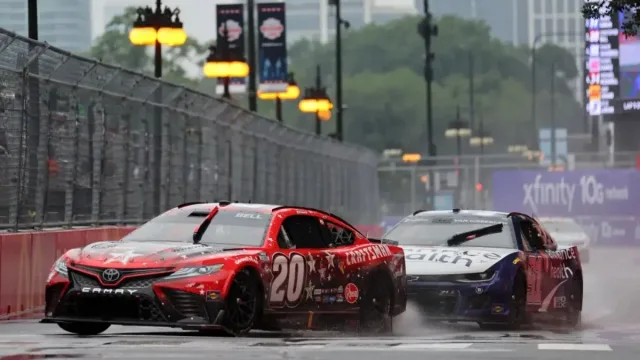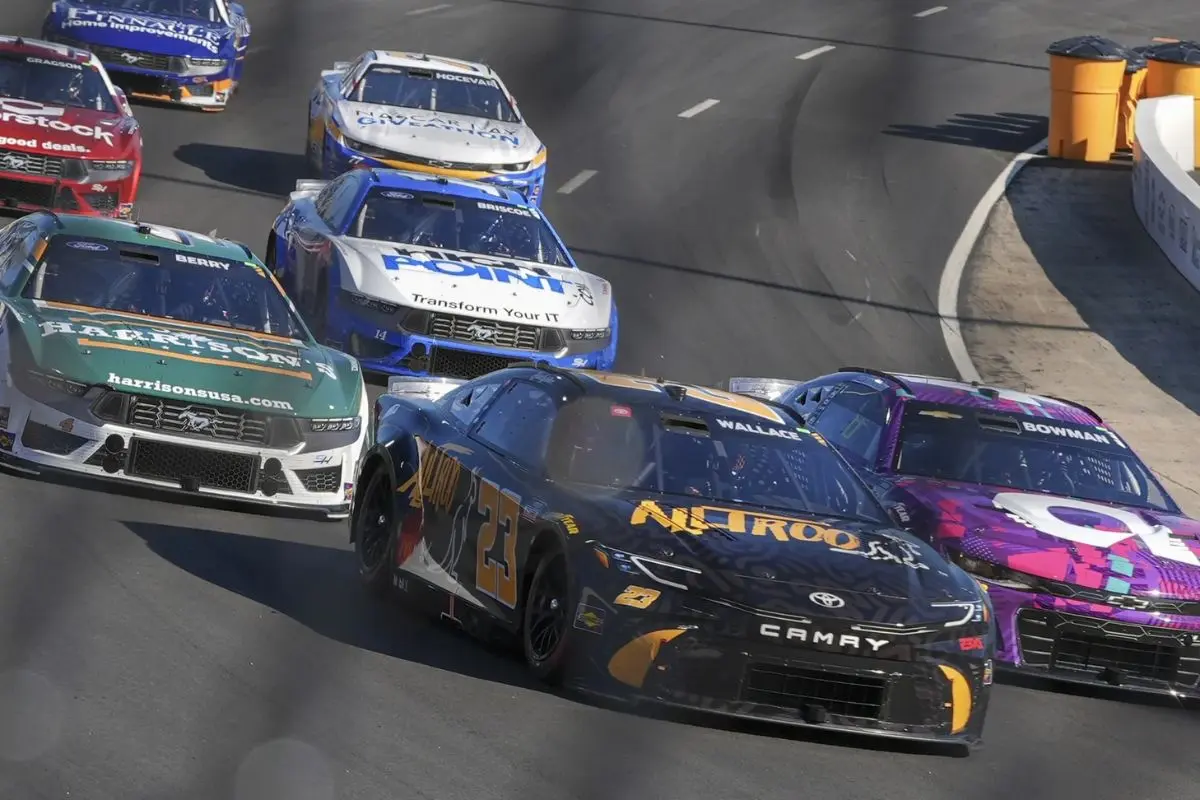How NASCAR Fights Against Rain: When rain threatens a NASCAR race, quick decisions shape the outcome. Teams adapt strategies, switching to specialized wet weather tires to tackle slick tracks. The risks of low traction complicate the psychological landscape for drivers. NASCAR officials balance safety and competition, often leading to temporary pauses or race rescheduling, as seen with the Daytona 500 in 2024.
Key Highlights
- Rain can lead to race delays or rescheduling, impacting team strategies and fan engagement, as seen with the Daytona 500 in 2024.
- NASCAR employs wet weather tires for enhanced traction during light rain, primarily at road courses and smaller tracks.
- Teams must quickly adapt their race strategies to changing weather conditions, including switching to wet weather tires when necessary.
- Advanced track drying technology, like Air Titan 2.0, efficiently removes water to minimize delays and keep races on schedule.
- The Weather Protection Program offers fans ticket exchanges for postponed events, enhancing their experience despite weather disruptions.
Impact of Rain on the 2024 NASCAR Season
How greatly does rain alter the dynamics of a NASCAR season? The 2024 NASCAR Cup season serves as a compelling case study, with rain influencing six of the 36 races, showcasing the unpredictable nature of motorsport. Weather conditions dramatically affect race strategies, team preparations, and driver performance. In these instances, teams are compelled to adapt quickly, shifting to wet weather tires when necessary, emphasizing the importance of flexibility in a sport where precision is paramount.
The impact of rain extends beyond mere tire changes; it fundamentally alters the race day experience. Events such as the Daytona 500, which had to be rescheduled to the following day due to inclement weather, demonstrate how rain can disrupt established routines and fan engagement. Rescheduling races is not a common practice in NASCAR, making such decisions noteworthy and indicative of the challenges posed by adverse conditions.
Moreover, the psychological aspects of racing in wet conditions cannot be overstated. Drivers must recalibrate their approach, maneuvering not only the physical demands of slick tracks but also the mental hurdles associated with uncertainty and risk.
The interplay between driver skill and environmental factors becomes even more pronounced, as those who excel in wet conditions can gain a critical advantage in the championship standings.
Joe Gibbs Racing Insider’s Explanation on Rain Delays
Rain delays have become a notable factor in NASCAR, particularly as teams navigate the complexities introduced by wet weather tires. According to a recent discussion by an insider from Joe Gibbs Racing, the evolution of tire technology has considerably altered how races are managed in wet conditions.
“NASCAR races get rescheduled because of rain when your tires look like this. Water on the track can cause chaos in previous years any amount of rain would postpone a race but now we have a wet weather Tire.”
As of now it’s used at road courses and smaller tracks and it continues to be tested at some of the bigger tracks.” – Joe Gibbs Racing Insider
Historically, any sign of precipitation would often result in immediate race postponements; however, the introduction of wet weather tires has changed this paradigm. These specialized tires, currently utilized primarily at road courses and smaller tracks, are subject to ongoing testing at larger venues.
While they cannot withstand torrential downpours, they have proven effective in maintaining traction during light rain or damp conditions, enabling race officials to make more informed decisions about track viability. The insider emphasized that the presence of water on the track can lead to chaos, yet the improved tire technology aims to mitigate this.
“While it can’t handle torrential rain it’s been effective at getting cars back on track in damp conditions if it rains at all at some of the bigger tracks or too much at some of the smaller tracks races may have to be delayed sometimes minutes, sometimes hours and sometimes even days.” – Joe Gibbs Racing Insider
Despite these advancements, rain delays remain unpredictable. Races might face postponements ranging from mere minutes to several hours or even days, depending on the intensity of the rainfall and track conditions.
The insider’s remarks highlight the delicate balance NASCAR must strike between safety and competition, as teams and officials must remain vigilant to changing weather patterns. Ultimately, the incorporation of wet weather tires is a step toward resilience, yet the dynamic nature of rain necessitates ongoing adaptation and tactical planning within the sport.
Notable Races Affected by Rain in 2024
The unpredictable nature of weather has had a considerable impact on several key races in the 2024 NASCAR season, illustrating the ongoing challenges teams face when confronted with rain-soaked tracks. The season opener, the Daytona 500, was rescheduled from Sunday to Monday due to persistent heavy rain, setting a precarious tone for the year ahead. This early disruption highlighted the delicate balance between race planning and the whims of nature.
Later, the Toyota Owners 400 at Richmond Raceway demonstrated the complexities of racing on damp surfaces, as competitors began the race on wet weather tires. The tactical decisions made by teams in response to these conditions became crucial, emphasizing the critical role tire selection plays in performance.
The AdventHealth 400 at Kansas also faced notable delays due to continuous showers, further complicating teams’ preparations and strategies.
The Coca-Cola 600 at Charlotte Motor Speedway was particularly remarkable, as Kyle Larson, fresh from a rain-delayed Indianapolis 500, arrived only to find the race red-flagged for ongoing rain and lightning. Ultimately, the event was called after 249 laps, with Bell declared the winner, a confirmation of the unpredictable dynamics of weather in NASCAR.
Rain also blemished the Chicago Street course, necessitating the use of wet weather tires once again. Furthermore, inclement weather led to the cancellation of qualifying for the FireKeepers Casino 400 in Michigan, highlighting the persistent influence of rain on the 2024 season’s racing landscape.
NASCAR’s Weather Protection Program for Fans
As weather-related disruptions continue to challenge the NASCAR season, the organization has implemented a Weather Protection Program to address fan concerns and minimize disappointment. This initiative primarily focuses on providing fans with flexible options in the event of race delays or cancellations due to inclement weather, emphasizing NASCAR’s commitment to enhancing the spectator experience.
While direct cash refunds are not part of the program, NASCAR allows fans to exchange their tickets for a future event of equal or lesser value. This policy is particularly beneficial for those who may have traveled long distances to attend a race, ensuring that they still receive value for their investment. Fans have a window of 60 days to initiate these exchanges, allowing them ample time to plan their next NASCAR experience.
However, it is crucial to note the stipulations surrounding ticket exchanges. If a race is merely postponed to later the same day, ticket holders who cannot attend are not eligible for exchanges.
This limitation reflects the challenges NASCAR faces in balancing operational logistics with fan satisfaction. The organization must also consider the financial implications of offering refunds or exchanges while maintaining the integrity of the sport.
Evolution of Track Drying Technology in NASCAR
Recognizing the critical impact of weather on race schedules, NASCAR has continuously evolved its track drying technology to minimize disruptions and improve the racing experience. The expedition began with low-flying helicopters, a method that was abandoned after a 1969 incident in Michigan highlighted the risks associated with aerial drying.
Subsequently, NASCAR utilized race cars to push water to the track’s periphery, a technique that proved unpopular among drivers due to its inefficiency and potential for damage. In response to growing dissatisfaction, NASCAR introduced jet dryers mounted on pickup trucks, capable of heating the track with air temperatures reaching 1100 degrees Fahrenheit.
However, this approach was not only resource-intensive—consuming 200 gallons of fuel per hour—but also limited in effectiveness, leading to further innovation demands. The introduction of the Air Titan in 2013 marked a notable advancement, although it still fell short of ideal cost-effectiveness.
The evolution culminated with the rollout of the Air Titan 2.0, which has become the standard in modern NASCAR track drying. This sophisticated system expels air at speeds exceeding 500 mph, efficiently dispersing water from the surface.
While the Air Titan 2.0 may not be the final word in track drying technology, it represents a crucial step in NASCAR’s ongoing commitment to enhancing race-day conditions. As technological advancements continue, NASCAR remains dedicated to refining these tools, ensuring that rain delays become increasingly rare, thereby preserving the integrity and excitement of the sport.
News in Brief: How NASCAR Fights Against Rain
The challenges posed by rain during NASCAR events necessitate a thorough approach to mitigate disruptions. Strategies employed by teams, such as cutting-edge drying technologies and the Weather Protection Program, highlight the commitment to maintaining race integrity. The insights from industry insiders reveal the intricate balance between fan experience and operational efficiency. As illustrated throughout the 2024 season, adaptability in the face of unpredictable weather remains crucial for sustaining the excitement and continuity of NASCAR racing.
ALSO READ: JTG Daugherty Rebrands to Hyak Motorsports in Desperate Move to Save NASCAR Future



